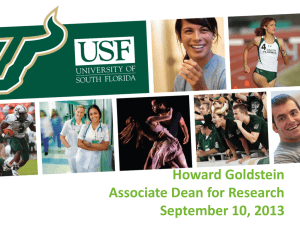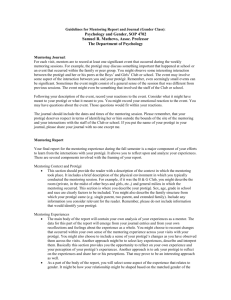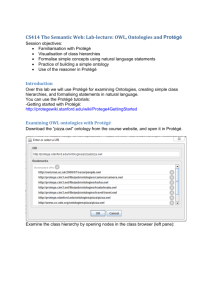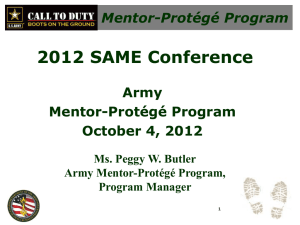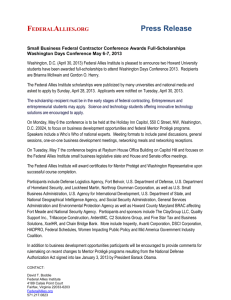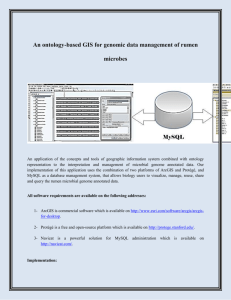Thank you for agreeing to be an advisor. If this is a new role, you
advertisement
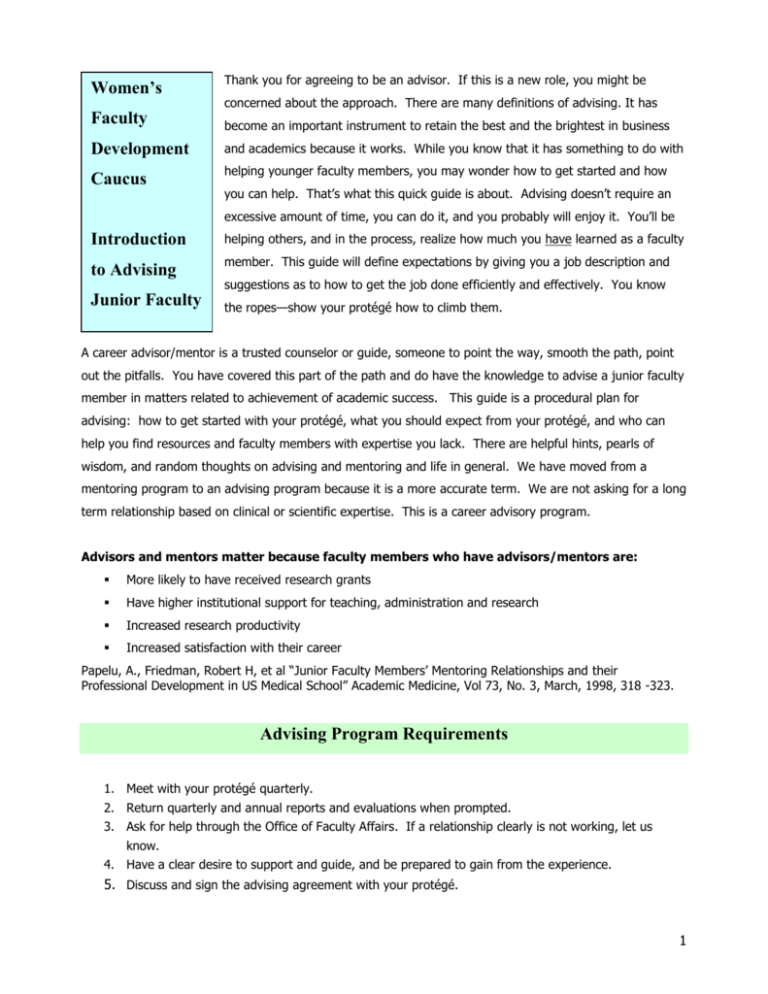
Women’s Thank you for agreeing to be an advisor. If this is a new role, you might be Faculty become an important instrument to retain the best and the brightest in business Development and academics because it works. While you know that it has something to do with Caucus concerned about the approach. There are many definitions of advising. It has helping younger faculty members, you may wonder how to get started and how you can help. That’s what this quick guide is about. Advising doesn’t require an excessive amount of time, you can do it, and you probably will enjoy it. You’ll be Introduction to Advising Junior Faculty helping others, and in the process, realize how much you have learned as a faculty member. This guide will define expectations by giving you a job description and suggestions as to how to get the job done efficiently and effectively. You know the ropes—show your protégé how to climb them. A career advisor/mentor is a trusted counselor or guide, someone to point the way, smooth the path, point out the pitfalls. You have covered this part of the path and do have the knowledge to advise a junior faculty member in matters related to achievement of academic success. This guide is a procedural plan for advising: how to get started with your protégé, what you should expect from your protégé, and who can help you find resources and faculty members with expertise you lack. There are helpful hints, pearls of wisdom, and random thoughts on advising and mentoring and life in general. We have moved from a mentoring program to an advising program because it is a more accurate term. We are not asking for a long term relationship based on clinical or scientific expertise. This is a career advisory program. Advisors and mentors matter because faculty members who have advisors/mentors are: More likely to have received research grants Have higher institutional support for teaching, administration and research Increased research productivity Increased satisfaction with their career Papelu, A., Friedman, Robert H, et al “Junior Faculty Members’ Mentoring Relationships and their Professional Development in US Medical School” Academic Medicine, Vol 73, No. 3, March, 1998, 318 -323. Advising Program Requirements 1. Meet with your protégé quarterly. 2. Return quarterly and annual reports and evaluations when prompted. 3. Ask for help through the Office of Faculty Affairs. If a relationship clearly is not working, let us know. 4. Have a clear desire to support and guide, and be prepared to gain from the experience. 5. Discuss and sign the advising agreement with your protégé. 1 Mentoring Supplies 1. The Advisor’s Advisor 2. The advising agreement 3. The name and contact information of your protégé 4. Your protégé’s CV 5. Career Strategic Planning Template What is an Advisor’s Responsibility? 1. Serve as a trusted guide for one year You are agreeing to advise your protégé for one year beginning October, 2006. At the end of the year, you are no longer obligated to continue meeting. If you continue the relationship, you are free to set up your own guidelines and expectations. Ideally, the goals of an advising program revolve around developing professional academic skills—how to integrate the norms, values and expectations of the academic health center, how to manage a productive career, and how to develop a useful network of professional colleagues. 2. Arrange the first meeting Call your protégé to set up the initial meeting – soon! The first quarterly reports are due in late December. Set aside about an hour for the first contact. It can be in your office, on campus, off campus, over coffee, lunch, or whatever works best. Research indicates that meetings and food are a good combination. Some of the best meetings are off campus and off hours. Get acquainted with her as a person first. Married? Kids? Interests? Find out some of the things that make her unique and different, then move on to short and long term goal setting and career advice by setting high standards, providing a vision of accomplishment, and supporting her through effective feedback. Ask your protégé what she hopes to gain from the relationship. Prepare an agenda and review the mentoring agreement, her CV, discuss career track and percentages of time, promotion and tenure requirements, obstacles to performance, gaps in knowledge, and an overview of scholarship. Advise about committee service, time management, and maintaining a balanced life. Give as an assignment the development of 5 and 10 year goals and priorities. Protégés report this is very useful as a device for clarifying professional career needs. It is a useful reference point for discussion. A basic technique for a successful start in academic medicine is to begin with the end in mind. If possible, schedule your next meeting right away or make plans to talk by phone or email for a follow up on goals assignments. We ask that you meet 4 times a year. In the intervals, you can email, talk by telephone, and please remember to include your protégé in networking and career building events. 2 3. Follow up in subsequent meetings o In reviewing where your protégé is in relation to promotion and tenure, look at things like committee assignments (is she overburdened with administrative or committee responsibilities that will do little to advance her academic career or achieve her goals?). Does she have departmental guidance? Does she know how to handle difficult conversations or how to negotiate? Ask about educational and research skills—there are many resources on campus to help build these skills—encourage your protégé to do ask for help. o Advising is like any relationship between two people – it takes time to grow, or not. You don’t have to really like your protégé to help her. There is no one right advising/mentoring method. Whatever works for you and your protégé is right for this relationship as long as there is mutual respect and genuine interest. o Review goals and annual performance reviews, give advice about attending local and regional meetings, clarify evolving protégé goals and interests, and examine career possibilities. This is not a static field – encourage her to be prepared for change. o Women often have special needs related to family responsibilities. There are many solutions to dealing with these challenges and many resources on campus to help. Call if you need help or can’t remember when your kids were toddlers. 4. Publicly support protégés and help them expand professional networks (Paraphrased advice from the AAMC - www.aamc.org/members/facultydev/facultyvitae/fall06/feature.htm) o Advisors should visibly promote the scholarship of protégés. You can do this through public endorsement of achievement, coaching in graceful self-promotion, and introducing protégés to colleagues who can broaden their networks. o Public endorsement increases confidence to take risks, network, and explore new avenues for personal and professional growth. Advisors also can help protégés learn effective methods of graceful self-promotion. Women and minority faculty, in particular, may be reluctant to tout their own achievements. o Networks are a vital part of professional development. Research has shown that the networks of women are not as high in quality or effectiveness as the networks of men, but we think they work pretty well here at UAMS. How can an advisor create opportunities for protégés to gain access to important networks? Invite protégés as colleagues to meetings and events Introduce protégés to colleagues and peers inside and outside of the department and institution Encourage protégés to collaborate with influential others on projects, and Include protégés in informal social activities, which provide a forum for informal "work talk". 5. Conclude the program formally and help us evaluate 3 The original agreement between advisor and protégé has been fulfilled at this time, and it is important to formally acknowledge this by a meeting that brings the activity to an official close. This meeting does not preclude an ongoing relationship if both parties wish to continue one; it simply marks the end of the structured one year period. Now the relationship is yours to define. This meeting is the time to sum up review your protégé’s activities for the past year and discuss how they have or have not advanced her in relation to her interim and overall goals. Talk about the big picture and the future. Have goals been met, progress made, skills developed, tasks assigned and completed? Part of our project is to try to determine if advising is more successful when the advisor realizes she isn’t responsible for all aspects of the protégés career, but can act quite productively as a facilitator to help her protégé find help or advice from others who are more expert in a given area. The Office of Faculty Affairs will act as a clearinghouse of information – please get in touch with Glenda J. Cooper for resource information and refer to our web page for more resources, particularly the Speaker’s Bureau: http://uams.edu/cmefa/faculty_affairs/speakers_bureau.asp FAQS—Frequently Asked Questions 1. Who should set up the first appointment? You are a person of influence, wisdom, and a certain maturity. The protégé as a junior faculty member may feel awkward about initiating a conversation or a meeting. If you set the first appointment, it simply makes it easier for her and defines you as someone who will make the relationship work to her benefit. Protégés generally report feeling uncomfortable about having to make the first move. Be organized and do what you say you will—that’s integrity and personal responsibility. 2. Why should I set up the appointment with a faculty resource person? Part of being an advisor is helping your protégé learn the ropes by introducing her to people who can help her advance in academics. In this case, you can help find a resource person on campus with the expertise your protégé needs. In doing so, you demonstrate the attributes of collegiality and leadership. 3. We don’t seem to be hitting it off? To have a productive relationship you don’t have to be totally compatible and the agreement is for one year only. Also, you may be looking for more than you need to have a good advisory relationship. Advising can work with good structure, good intentions and relevant information. You help define her career goals and steer her through the maze of academic medicine. It’s a little bit of coaching, counseling, role-modeling and advocating. If you perceive a problem, taking the time to think through a problem often suggests the solution. Does your protégé feel the relationship is not working? Does she have concerns? Are appointments missed? Why? It’s possible than an examination of the problem will lead to a better mentoring experience for both. If the protégé seems happy, maybe you are expecting more than necessary and the arrangement is working. 4 Setting goals and expectations at the first meeting can clarify the expectations and minimize unpleasant experiences. 4. We both decide the relationship isn’t working? Then it probably isn’t working. Discuss the issues with the mentoring director who should know about your problems so that both parties may be reassigned more appropriately. You can be reassigned. Remember, your records, problems, issues are all confidential. 5. What if my protégé neglects appointments? Scheduling and finding time for meetings is increasingly difficult in this busy environment. Bad feelings arise when either the mentor or the protégé miss a meeting – particularly when one is left waiting with little or no warning. It is very important to keep appointments. It is very important to respond to emails. If your protégé misses a scheduled meeting, discuss it. Follow up. Sometimes circumstances beyond her control arise – we all know how that can happen in medicine. Let her know that you set aside time for meetings and that it is important for her to honor her appointments. Again, integrity is an issue. If this “no show” habit persists, let the advising director know. Advisors and protégés aren’t obligated to spend time chasing down each other. Common courtesy will build trust. 6. This whole project is taking much more time than I expected or can spare? Maybe you are trying to do too much!! You may be doing more for and with your protégé than is required for an advisory relationship. Review your goals for the relationship. Having too ambitious an agenda may jeopardize the intent of assisting a young faculty member navigate the UAMS system and academic medicine as a social/political system. Reassess and discuss time issues with your protégé. Promotion and Tenure Guidelines New faculty need to know they are responsible for their career. From your first day, you need to know and do specific things if you want to be productive, promoted and granted tenure. Even if your department or division provides help, it is basically a “do it yourself project.” The Faculty Affairs Promotion and Tenure page has added more information valuable to the P/T process: http://www.uams.edu/facultyaffairs/Promotionandtenure/default.asp Upon appointment, she should have received a copy of the current P/T document with a welcoming packet, the cover sheet, the Unofficial Faculty Handbook, and other tracking forms. Advise her to begin recording academic activities, including educational productivity. She should attend the promotion and tenure workshops in June, go to faculty meetings, guest lectures, professional development events, and network as much as possible. More information below: 1. Your appointed track - The tenured choices are Basic Scientist, Clinical Scientist, and Clinical Educator. The untenured tracks are Research Scientist and Clinical Attending - these appointments are made on an 5 annual basis. If unclear about your track, find your letter of appointment, call your departmental administrator, or call Connie Albert in the Faculty Affairs Office. 2. Changing tracks - If you believe you are in the wrong track, you have a one-time option to request an evaluation of your track at the end of 36 months from date of hire. If your chair and the Dean approve, you may be reassigned to another track. Once this change is made, it is final. 3. Who determines how one’s time is allocated? The chair should meet with new faculty members before the initial appointment to outline responsibilities and expectations. New faculty members must understand what percentage of their time should be devoted to research, teaching, and service so they can plan accordingly. In some of the larger departments, the division director may make these determinations. Just be sure your protégé knows her departmental expectations and how to document her time accordingly. If she is down for 50% research, her productivity should reflect that. This is where your advice can be critical. 4. What is tenure and what is the “tenure clock”? Tenure grants a faculty member the right of continuous appointment although not full salary. You must be a full time employee on a traditional academic track to be eligible for tenure. The years prior to tenure are the probationary period, and the granting of tenure marks the end of probation. If on the tenured pathway, you must gain tenure within 7 years of the initial appointment. If you have not been granted tenure by the beginning of the 7th year, that appointment is considered a terminal year. The tenure clock begins with the initial appointment which must be at the level of assistant professor or above to trigger the clock. The academic year begins July 1. If appointed between July 1 and December 31, that period of time counts as a year. If appointed from Jan 1 to June 30, it is not counted as a year. Pearls of Wisdom about a Career in Academic Medicine There are 4 dimensions of career development - deciding, designing, doing and documenting. Put the cover sheet of the Promotion and Tenure document on your computer & organize your C.V. appropriately. Keep it updated. Document the time you spend teaching & keep your student/resident evaluations. This is very important. The P/T committee considers first, second and last authorship on scholarly work the most important. If you are well into the middle, but do considerable work, write that into your statement. Keep up with changes in scholarly publication; for more information, contact Jan Hart, EdD, in the UAMS Library. Family and Medical Leave—know the rules! Board Policy 405.1 "During the first six years of the probationary period, a tenure-track faculty member may request, for reasons set forth below, that the probationary period be suspended by one (1) year. The reasons for such a request are the same as required under the Family and Medical Leave Act of 1993 and are as follows: (a) the birth of a child to the faculty member or his spouse and its care during the first year; (b) the adoption of 6 a child by the faculty member or placement in the faculty member/s home of a foster child; (c) the care of the faculty member's spouse, child, or parent with a serious health condition; (d) the serious health condition of the faculty member." Researchers - Connect immediately with someone who has expertise in navigating the UAMS system for hiring personnel and purchasing equipment and supplies. Talk to the Office of Research Administration for assistance. The Office of Grants and Scientific Publications offers grant writing assistance and the Research Committee of the Women’s Caucus can offer guidance. The Office of Faculty Affairs is gathering information about a growing number of mentoring opportunities for researchers. Call us and check out our new Speaker’s Bureau page for resources: http://www.uams.edu/facultyaffairs/speakers_bureau.asp. Explore the useful links page for scientists: http://www.uams.edu/facultyaffairs/links.asp. Colleagues can give good, critical feedback regarding papers and grants. Ask questions. Go to faculty meetings, P/T workshops, and professional development workshops; network. Another technique for academic success is to know your discipline’s experts, network, and make sure they know you!! Be a leader at every level. Encourage your protégé to seek out mentoring in all shapes and sizes. Thank you for being an advisor this year. Advising/mentoring is a growing, vital effort in the business world and in academic medicine because it works. The goal is to ensure that all women reach their full potential. Your generosity of spirit and time will better prepare our junior faculty for a productive, fully realized career. _____________________________________________________________________________________ The Women’s Faculty Development Caucus, UAMS College of Medicine 2005 – 2007 Officers President: Kathleen Gilbert, PhD, Associate Professor, Microbiology and Immunology Vice-President: Mary Aitken, MD, PhD, Associate Professor, Pediatrics Secretary: Dana Gaddy, PhD, Associate Professor, Pediatrics Mentoring Committee: Chair: LJ Perrot, MD, JD, Professor, Pathology Co-Chair: Linda Deloney, EdD, Instructor, Radiology For more information about the Advising Program, resource personnel, or concerns about your match, please contact Glenda J. Cooper at 501.526.4685 or email cooperglendaj@uams.edu. The Women’s Caucus website: http://www.uams.edu/facultyaffairs/wfdc_files/wfdc.asp Glenda J. Cooper Director, Faculty Affairs Office of CME and Faculty Affairs UAMS College of Medicine 1.501.526.4685 7 2006 – 2007 ADVISORY PROGRAM 8
